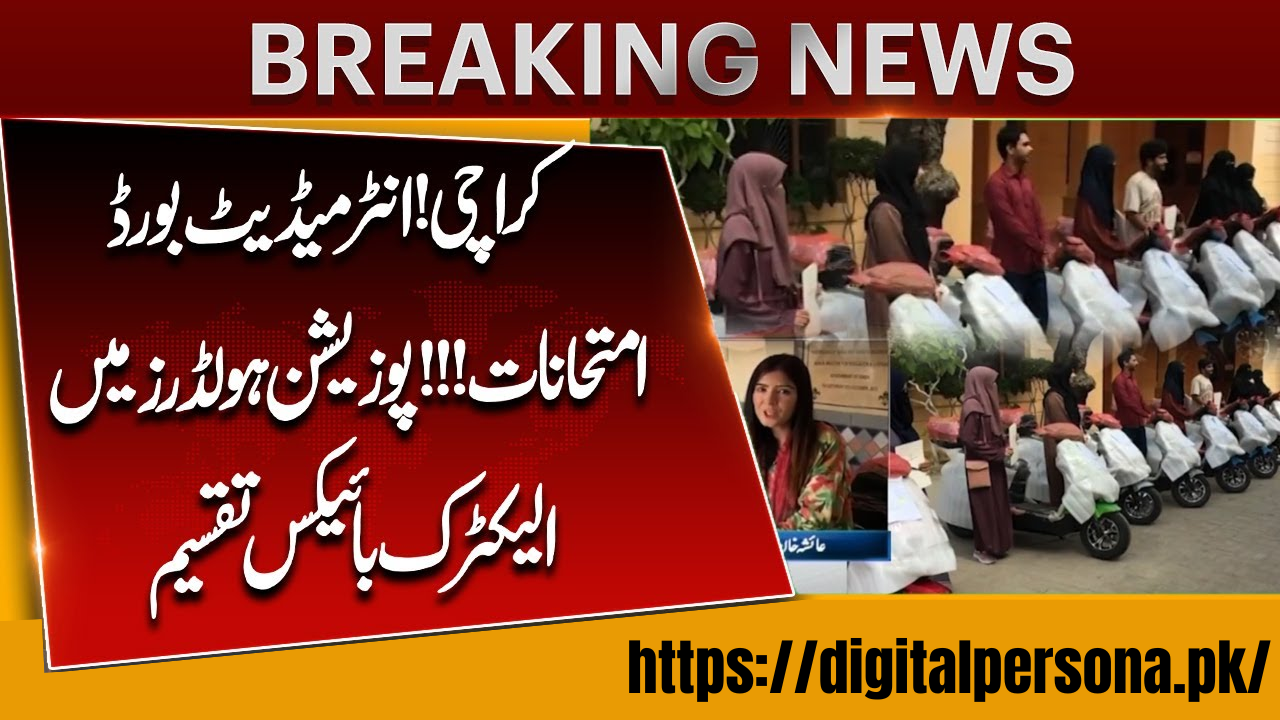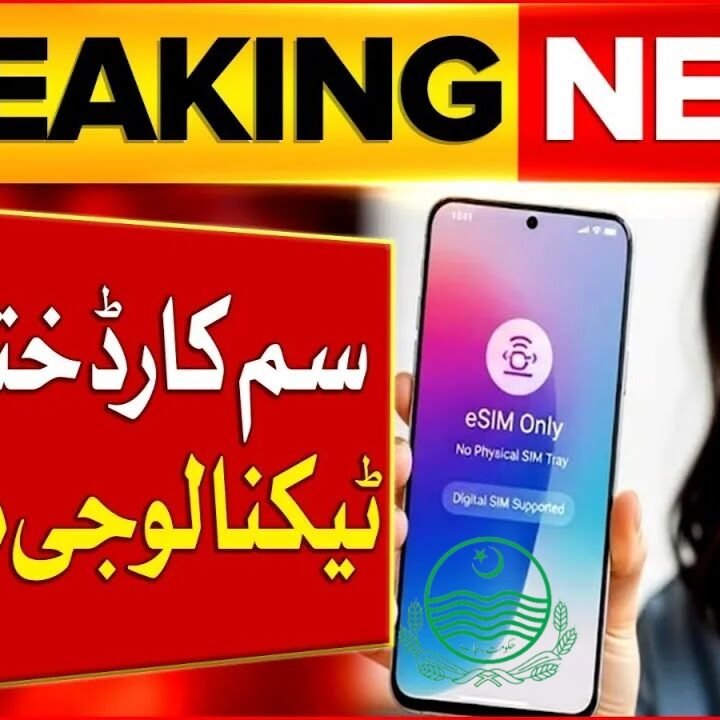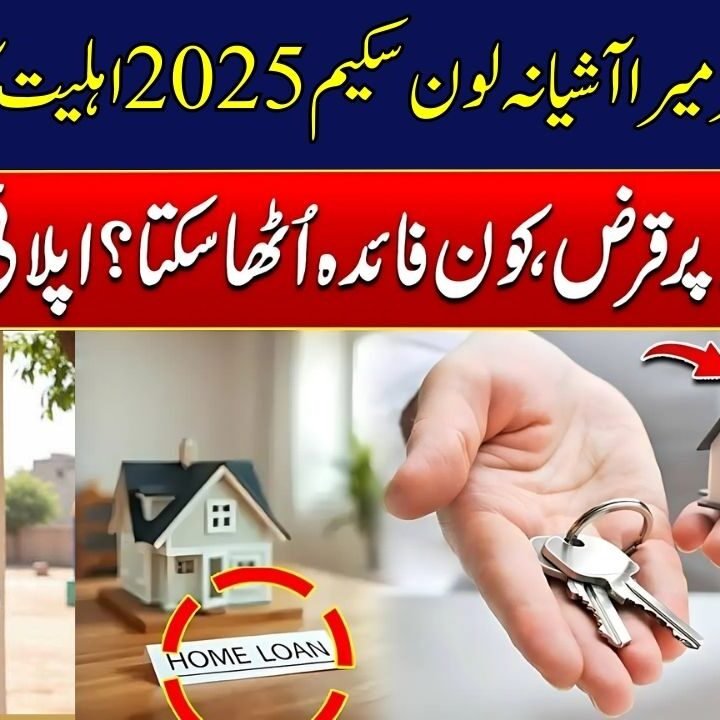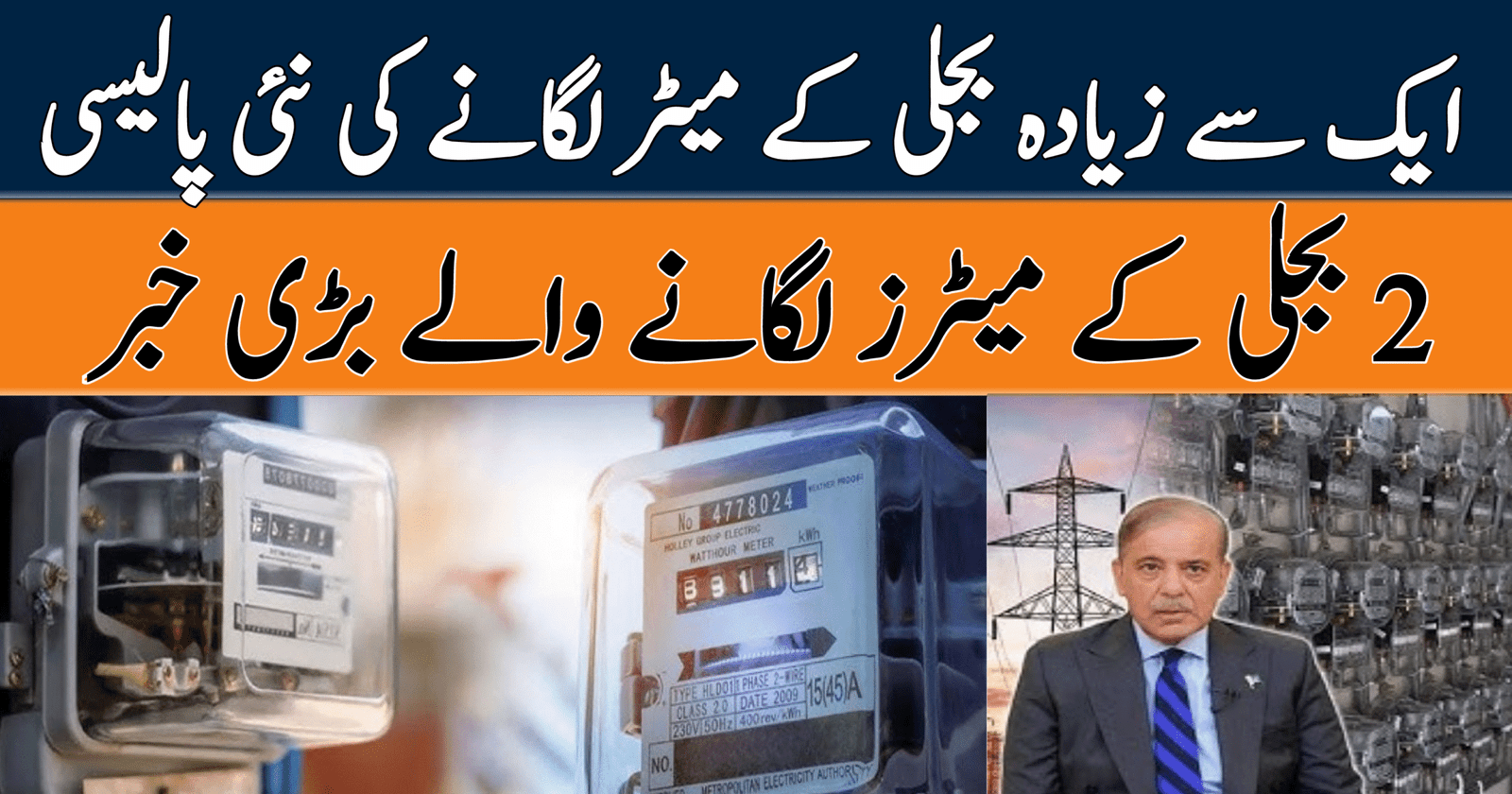Final Date for Solar Panel Scheme 2025 Registration
The Government of Sindh has hurled a Solar Panel Solar Home System (SHS) scheme 2025 aimed especially at low-income and undeveloped (hari) households to reduce electricity loads and endorse clean energy. The last date to submit applications is October 20, 2025. Farmers and rural families in Sindh are being powerfully urged to apply beforehand this deadline, because late applications will not be accepted. This article stretches you everything you need to know: who qualifies, what benefits you get, how to apply, costs & subsidies, required documents, and tips to get your application accepted — so you don’t essential to search away
Quick Info Table: Final Date for Solar Panel Scheme 2025 Registration
| Field | Details |
|---|---|
| Name of the Program | Sindh Solar Panel / Solar Home System Scheme 2025 |
| Final Date for Application | october 20, 2025 |
| Target Beneficiaries | Low-income households and farmers (hari) in Sindh |
| Maximum Electricity Usage Criterion | Under 100 units/month average |
| Subsidy / Cost Share | Government covers ~ 80%, applicant ~ 20% |
| Method of Application | Offline (form submission to Sindh Energy Department / designated offices) |
| Verification & Approval | Through Sindh Energy Department / relevant agencies |
| Extras included | Solar panel, battery, LED lights, fan, wiring & necessary accessories |
What Is the Sindh Solar Panel Scheme 2025?
The Final Date for Solar Panel Scheme 2025 Registration (also named the Solar Home System or SHS program) is share of the Sindh Solar Energy Project (SSEP) — a provincial initiative in collaboration with growth partners (e.g. World Bank) to increase admission to clean solar liveliness in Sindh.
Under this scheme, selected low-income families and farming families (who meet eligibility) get subsidized solar systems for their homes and agricultural needs. The intent remains to reduce power bills, ease power outages (load-shedding), and promote maintainable, eco-friendly energy acceptance in rural areas.
In 2025, the Sindh government proclaimed that it would allocate 200,000 solar home systems to low-income households across the province. Later, they also declared plans to enlarge it further (addition 500,000 more systems) to reach more relations.
Each distributed system typically includes:
- Solar panel(s)
- Battery backup
- LED bulbs
- Wiring & control / management units
- A pedestal fan (in some packages)
This makes it a more complete “home solar kit” rather than just a bare panel.
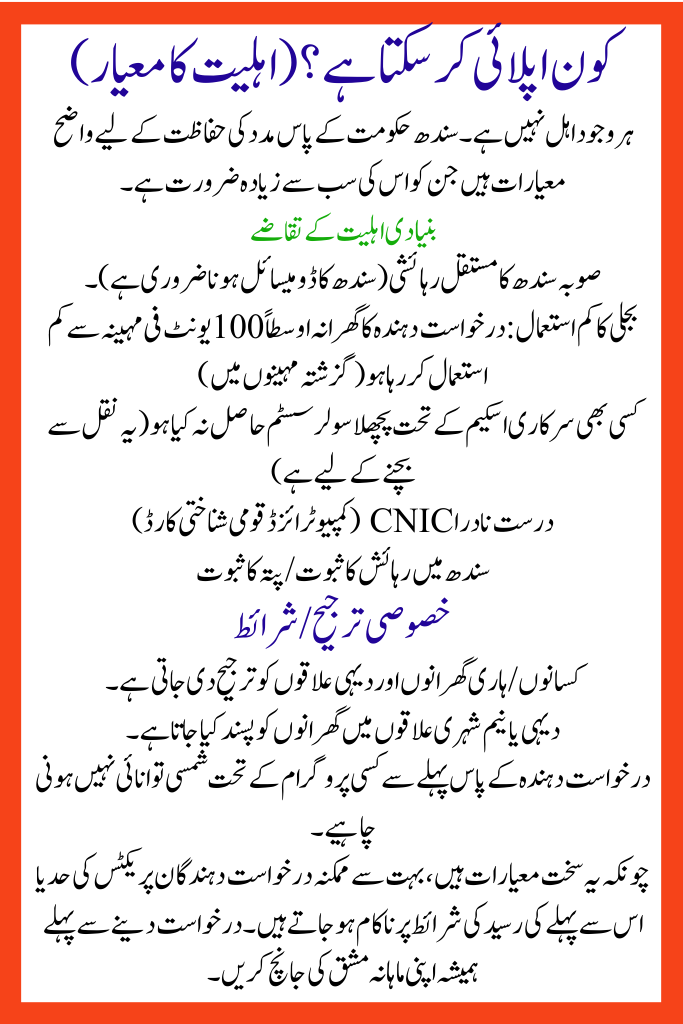
Who Can Apply? (Eligibility Criteria)
Not every being is eligible. The Sindh government has clear clear standards to safeguard the help goes to persons who most need it.
Primary Eligibility Requirements
- Permanent resident of Sindh province (must have Sindh domicile).
- Low electricity usage: The applicant’s household should be consuming under 100 units per month on average (over past months)
- Must not have received a previous solar system under any government scheme (this is to avoid duplication)
- Valid NADRA CNIC (Computerized National Identity Card)
- Residence proof / address proof in Sindh
Special Preference / Conditions
- Priority is given to farmers / hari households and rural areas.
- Households in rural or semi-urban areas tend to be favored.
- The applicant must not have solar previously under any prior program.
Since these are strict criteria, many potential applicants fail on the practice threshold or preceding receipt conditions. Always checked your own monthly practice before applying.
Key Benefits of the Final Date for Solar Panel Scheme 2025 Registration (Why It Matters)
This Final Date for Solar Panel Scheme 2025 Registration is not just a handout — it carries multiple advantages, especially for rural and farming families in Sindh:
1. Major Reduction in Electricity Bills
By switching parts of your consumption to solar, your reliance on grid electricity drops. Over time, that means saving thousands of rupees per month.
2. Relief from Load Shedding
In many rural areas, frequent power cuts are common. With a solar system and battery backup, you’ll get more reliable electricity when the national grid fails.
3. Environmental / Clean Energy
This is renewable energy. Less reliance on imported fuel, lower carbon emissions, and a greener Sindh overall.
4. Support for Farming / Agriculture
For farmers, solar power can run tube wells, pumps, drip irrigation systems — helping reduce diesel or electric pump costs.
5. Government Subsidy / Affordability
The government covers a major share (about 80%) of the system cost for lower-income beneficiaries. You only pay your share, making it much more accessible.
6. Improved Quality of Life
With better electricity, children can study at night, households can use fans, lights, and small appliances more comfortably without fear of high bills.
7. Scale / Inclusion
The scheme aims to reach hundreds of thousands of households, so even remote areas may be included.
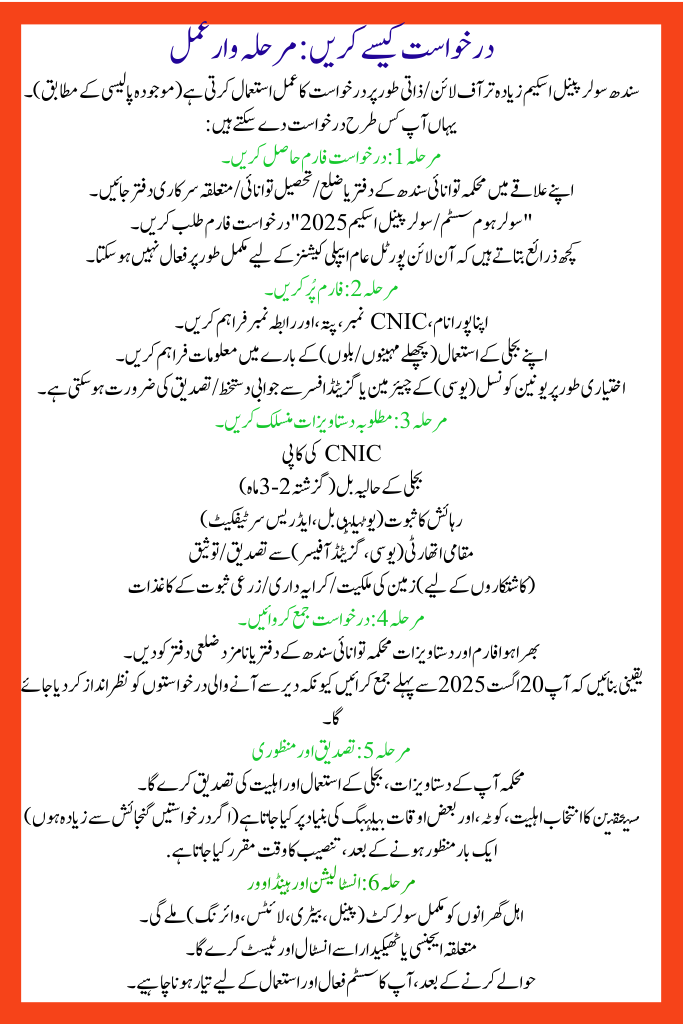
How to Apply: Step by Step Process
The Sindh Solar Panel Scheme uses a mostly offline / in-person application process (as of current policy). Here’s how you can apply:
Step 1: Get the Application Form
- Go to Sindh Energy Department office or District / Tehsil energy / relevant government office in your area.
- Ask for the “Solar Home System / Solar Panel Scheme 2025” application form.
- Some sources suggest the online portal may not be fully functional for general applications.
Step 2: Fill Out Form
- Provide your full name, CNIC number, address, and contact number.
- Provide information about your electricity usage (previous months / bills).
- Optionally countersign / verification from Union Council (UC) Chairman or a Gazetted Officer may be required.
Step 3: Attach Required Documents
- Copy of CNIC
- Recent electricity bills (last 2–3 months)
- Proof of residence (utility bill, address certificate)
- Verification / attestation from local authority (UC, gazetted officer)
- (For farmers) Land ownership / tenancy / agricultural proof papers
Step 4: Submit the Application
- Hand in the filled form and documents to the Sindh Energy Department office or designated district office.
- Make sure you submit before October 20, 2025 because late applications will be ignored.
Step 5: Verification & Approval
- The department will verify your documents, electricity usage, and eligibility.
- Beneficiaries are selected based on eligibility, quota, and sometimes balloting (if applications exceed capacity)
- Once approved, installation is scheduled.
Step 6: Installation & Handover
- Qualified households will get the full solar kit (panel, battery, lights, wiring).
- The relevant agency or contractor will install and test it.
- After handover, your system should be functional and ready for use.
Costs and Government Subsidy / Sharing
One of the biggest attractions is that the government heavily subsidizes the cost, so you will pay only a portion. The breakdown:
| Category | Government Share | Applicant / Household Share |
|---|---|---|
| Low-income / eligible households | ~ 80% subsidy | ~ 20% paid by you |
| (In some references) slightly less subsidy for others | ~ 70% | ~ 30% |
| In some versions / other categories | ~ 60% | ~ 40% |
The main Final Date for Solar Panel Scheme 2025 Registration widely reported for 2025 is 80% government share and 20% from the applicant.
You should be ready to arrange your share of payment upon approval. The government’s portion is disbursed to the contractor/installer.
Final Date & Important Deadlines
The most critical fact:
Final date to submit your application is October 20, 2025.
Applications received after that will not be entertained under this scheme.
Because quotas are limited, applying early is strongly recommended — early valid applications may receive priority in processing.
Also, note: some news sources mention earlier “last dates” for certain distributions (e.g. January 5, 2025) for free panels in older phases. But for this 2025 scheme, the date August 20 is the most current.
Required Documents Checklist for Final Date for Solar Panel Scheme 2025 Registration
Make sure you have these before filling the form:
- Copy of CNIC (National Identity Card)
- Recent electricity bill(s) (last 2-3 months)
- Proof of residence / address in Sindh
- Verification / attestation from Union Council (UC) Chairman or gazetted officer (if required)
- Proof of non-receipt of solar under previous schemes
- (If applicant is a farmer) Land ownership / tenancy documents
Missing documents often lead to rejection, so ensure everything is correctly attached and attested.
Challenges & Pitfalls (And How to Overcome Them)
While the Final Date for Solar Panel Scheme 2025 Registration is very promising, there are challenges. Knowing these helps you prepare:
Low Awareness in Rural Areas
Many farmers may not even know of the scheme. Local outreach / awareness campaigns should help.
Tip: Visit your nearest Sindh Energy Department or district office and ask for details. Spread word among neighbors.
Submission Delays & Bureaucracy
In remote areas, getting the form, verifying with UC or a gazetted officer may take time.
Tip: Start early. Don’t wait till the last week.
Verification Failures
Your electricity usage may exceed the 100 units threshold, or you might be disqualified if you previously got solar.
Tip: Before applying, check your usage and whether you ever received solar under another scheme.
Quota & Balloting
If many people apply in one area, the department may use balloting to select among eligible applications.
Tip: Make sure your application is flawless, on time, and properly verified to maximize your chance.
Installation Quality & Maintenance
Poor workmanship or low-quality equipment can harm the system’s longevity.
Tip: After installation, test the system. Keep supporting documents and warranty info. Report issues.
Lack of Technical Support
Some users may lack knowledge for maintenance or minor repairs.
Tip: Request training or user guidance from the installing agency or local technician.
Real Updates & Recent Announcements (2025)
Here are some relevant updates:
- The Sindh government started distributing solar home-based systems to low-income families under this scheme, intending to reach 200,000 families.
- The government also proclaimed plans to extend this by adding 500,000 more solar systems across the province.
- In September 2025, it was stated that Sindh will issue Benazir Hari Cards to newly registered farmers. Through these cards, farmers owning between 5 and 25 acres may receive subsidized solar panels, with the government bearing 80% cost and agriculturalists 20%.
- The claim window for that farmer / panel scheme via Benazir Hari Card stood mentioned to remain open until September 20, 2025 at the Hyderabad Husbandry Water Seriatim office.
These parallel creativities may overlap or mix with the main solar scheme, so watch authorized notices for that section too.
Tips to Ensure Your Application Is Accepted
- Gather all documents early: CNIC, bills, resistant of residence, land leaflets (if relevant).
- Verify your electricity usage is under 100 units (or average over past months).
- Visit local offices well ahead of time to get the request form, ask queries.
- Get local attestation (UC Chairman, gazetted officer) in fee, if required.
- Submit before the deadline — don’t leave it for the previous days.
- Keep copies of everything you submit and a receipt of proposal.
- After submission, follow up with the Sindh Energy Section or district office to track status.
- Report any issues with fixing or system recital nearly.
Conclusion & Call to Action
The Final Date for Solar Panel Scheme 2025 Registration is a excellent chance for eligible rural then farmer families in Sindh to access clean vigor, save on energy bills, and lessen the load of power outages. With the final deadline of October 20, 2025, time is small.
If you qualify, don’t wait — collect your leaflets, get the request form, verify all early, acquiesce on time, and follow up. After reading this guide, you now have all the info you need — no more searching elsewhere.
Related Posts
